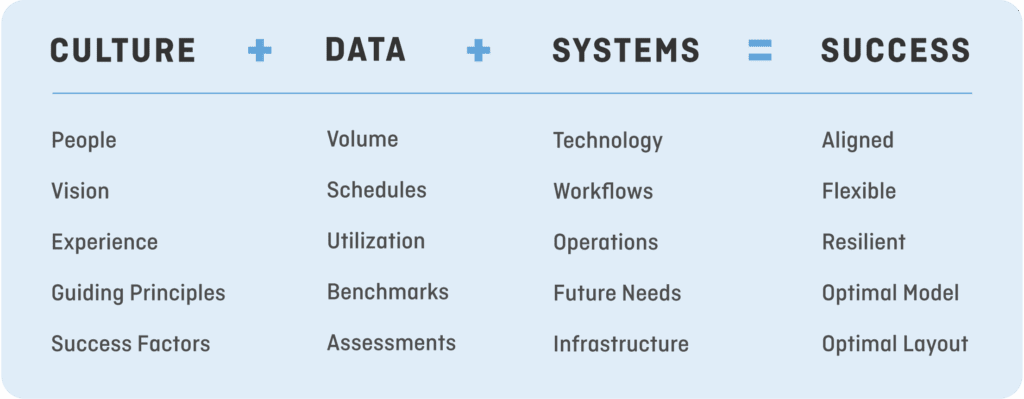
Optimizing Emergency Department Design: A Blueprint for Flexibility, Safety, and Resilience
Emergency Departments (EDs) are the front doors to hospitals and the safety nets for communities. But with rising patient volumes, complex care needs, and increasing safety concerns, designing these critical spaces requires more than just meeting code. It demands smart, adaptable solutions that improve both patient experience and operational performance.
Understanding the Pressures on Today’s ED
Despite the rise of urgent care clinics, ED usage continues to climb, particularly among older populations and those with limited access to preventive care. Emergency departments are also increasingly handling behavioral health cases, patients without insurance, and those with unmanaged complex chronic conditions.
This influx, combined with staffing shortages, slow inpatient boarding due to delayed admissions, and longer stays, is putting unprecedented stress on ED facilities. Add the lingering need for pandemic readiness, and it’s clear: EDs must be nimble, scalable, and designed for disruption.
What Does an Optimized ED Look Like?
An optimized ED isn’t just bigger, it’s smarter and built to maximize resource efficiency, minimize wait times, eliminate bottlenecks, support diverse patient needs, flex for abnormal events, and create a safer environment for staff and patients. No matter the scale, this framework provides a foundation for designing a future-ready ED.

Culture: Define Your Why
Culture is about defining your WHY and what will make the project a success. Establishing a shared vision provides a guide for decision making and fostering alignment throughout the project.
Data: Let the Numbers Lead
Data is the objective part of the equation that informs design decisions. The data you collect should include:
- Patient volumes by acuity
- Visits per treatment space
- Average length of stay
- Average and peak workloads
- Behavioral health trends
It’s important to compare this data to industry benchmarks to determine the right size, layout, and amenities – everything from universal exam rooms to low-acuity treatment areas.
But data alone doesn’t tell the full story. Context is key.
After all, EDs are connected to the entire health system. Consider these additional questions during your programming phase:
- Do you treat lower acuity patients in other settings? Or will those patients present at your ED?
- What is your inpatient average daily census? Are there barriers to admitting patients from the ED?
- Do you have a labor and delivery unit? If not, those patients may end up in your ED.
- What is your organization’s approach to behavioral health? Do you have behavioral health specialists in primary care?
Systems: Align Infrastructure and Operations
Systems refers to your operational, infrastructure, and technology factors. Buildings should support operations, not dictate them.
Understanding desired workflows, such as how you intend to register and triage patients, or your intended staffing model is critical.
Designing for Flexibility
The future of healthcare is unpredictable. That’s why flexibility is foundational in ED design. In 2022, the Facility Guidelines Institute (FGI) Guidelines began to encourage healthcare providers to think more creatively about flexible solutions, explicitly encouraging alternative design approaches that meet the intent of the standards.
When we talk about flexibility, it’s important we have a common language. There are three categories of space you should consider as you plan your ED: flexible space, adaptable space, and changeable space.

Flexible spaces can change use on demand with minimal relocation of furniture and equipment. Flexible space could include:
- Universal treatment rooms that meet the most restrictive use requirements can flex on demand between use types, from trauma to behavioral health.
- Low-acuity zones designed for chair-based care can offer fast treatment options for minor injuries, reducing strain on high-acuity beds. Low-acuity zones can also be used for results pending space.
Adaptable space can be reconfigured in a matter of a few days. Examples of adaptable space solutions include:
- Demountable walls that allow you to reconfigure space quickly and without construction.
- Movable nurse stations and modular cabinetry that can be reconfigured for privacy or alternate uses.
- Flex zones, such as conference rooms that convert to Hospital Incident Command Centers or pre/post-op bays doubling as ED space.
Changeable space requires some level of renovation to change from one use to another, which could take months. There are ways, however, to make these changes as straightforward and least intrusive as possible. Considerations should include:
- Upsizing mechanical, electrical, and med gas systems
- Stubbing in plumbing lines for future plumbing fixtures
- Locating soft spaces, such as conference rooms or admin space, near your ED for easier future expansion into those spaces.
The goal for designing with any of these flexible solutions in mind is to ensure every square foot of your ED earns its keep. Understanding your flexibility goals as early as possible will inform the programming and planning process.
Planning for Resiliency
Modern EDs must be ready for anything from pandemics to power outages so they can provide uninterrupted care 24/7.
Disaster preparedness is not an afterthought. Tools like the FGI’s Disaster, Emergency, and Vulnerability Assessment (DEVA) should guide your resiliency planning so the ED can stay operational and safe during crisis events. Consider any risks specific to your region such as the potential for chemical spills related to hazardous materials handling, extreme weather, adventure sports, or events where large crowds gather.
We also cannot forget the need for pandemic-ready design strategies which include increased ventilation rates, emergency exhaust systems, increased filtration, and ultraviolet germicidal radiation (UVGI). Each of these strategies have planning considerations to discuss with the design team.
Behavioral Health: Designing with Dignity and Safety
Behavioral health visits continue to rise, yet many EDs aren’t equipped to handle them. EDs are by nature loud, chaotic environments. Providing appropriate space for your behavioral health patients can reduce agitation and the need for sedation, keeping both patients and staff safe. Your behavioral health strategy should consider the following:
- Safe, quiet, naturally lit rooms with calming biophilic elements.
- Separately zoned behavioral health units with clear sightlines.
- EmPATH space—open, therapeutic spaces focused on wellness and recovery.
- Lockers, hygiene access, and patient dignity-features.
Optimizing ED design is about anticipating the needs of tomorrow. Through data-driven planning, modular flexibility, and an unwavering focus on resilience and safety, healthcare organizations can build EDs that work better, adapt faster, and care more deeply. After all, when it comes to emergency care, every second, and every square foot, counts.




